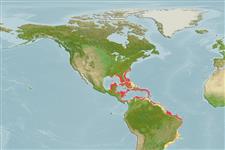Common names from other countries
Environment: milieu / climate zone / depth range / distribution range
Ecologia
marinhas associadas(os) a recifes; intervalo de profundidade 2 - 137 m (Ref. 5222), usually 5 - 35 m (Ref. 40849). Subtropical; 35°N - 28°S, 92°W - 33°W (Ref. 5222)
Western Atlantic: Bermuda, Gulf of Mexico and the Caribbean south to Sao Paulo, Brazil.
Length at first maturity / Tamanho / Peso / Idade
Maturity: Lm 53.6, range 50 - 63 cm
Max length : 100.0 cm TL macho/indeterminado; (Ref. 26340); common length : 50.0 cm TL macho/indeterminado; (Ref. 5217); peso máx. Publicado: 18.5 kg (Ref. 40637)
Espinhos dorsais (total) : 11; Raios dorsais moles (total) : 15 - 16; Espinhos anais: 3; Raios anais moles: 10 - 12. Distinguished by the following characteristics: Head and body have oval groups of dark spots; outer third of pectoral fin bright yellow (Ref. 26938); two color morphs: a deep-water reddish form and shallow-water greenish form; depth of body contained 2.9-3.2 times in SL; head length 2.6-2.9 times in SL; convex interorbital area; evenly rounded preopercle or with slight notch, without projecting bony lobe at the angle; nostrils subequal or posterior nostrils with diameter twice the size of anterior nostrils (Ref. 89707).
Adults found on rocky and coral reefs, juveniles occur in shallow turtle grass beds. Also been taken in trawls over mud bottom in the northern Gulf of Mexico. Feeds mainly on fishes (mostly on coral reef species) and squids. Although often implicated in ciguatera poisonings, it is a desirable food fish; and even large (5 to 10 kg) fish from areas considered safe are sold in markets. Also caught with surface trolling. Sex-reversal has been observed (Ref. 5521).
Heemstra, P.C. and J.E. Randall, 1993. FAO Species Catalogue. Vol. 16. Groupers of the world (family Serranidae, subfamily Epinephelinae). An annotated and illustrated catalogue of the grouper, rockcod, hind, coral grouper and lyretail species known to date. Rome: FAO. FAO Fish. Synop. 125(16):382 p. (Ref. 5222)
Categoria na Lista Vermelha da IUCN (Ref. 130435)
CITES (Ref. 128078)
Not Evaluated
Ameaça para o homem
Reports of ciguatera poisoning (Ref. 4690)
Utilização humana
Pescarias: altamente comercial; peixe desportivo: sim; Aquário: Aquários públicos
Ferramentas
Relatórios especiais
Descarregue XML
Fontes da internet
Estimates based on models
Preferred temperature (Ref.
115969): 24.3 - 28, mean 27 (based on 310 cells).
Phylogenetic diversity index (Ref.
82804): PD
50 = 0.5000 [Uniqueness, from 0.5 = low to 2.0 = high].
Bayesian length-weight: a=0.01122 (0.00720 - 0.01748), b=3.04 (2.92 - 3.16), in cm Total Length, based on LWR estimates for this species & Genus-body shape (Ref.
93245).
Nível Trófico (Ref.
69278): 4.5 ±0.5 se; based on diet studies.
Resiliência (Ref.
120179): Baixo, tempo mínimo de duplicação da população 4,5 - 14 anos (K=0.09-0.17; tmax=15; Fec=400,000).
Fishing Vulnerability (Ref.
59153): High vulnerability (62 of 100).
Climate Vulnerability (Ref.
125649): Very high vulnerability (86 of 100).
